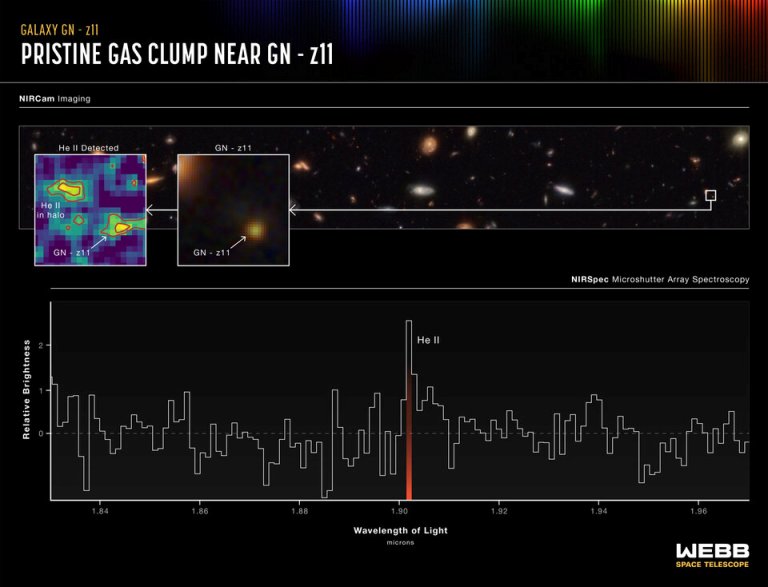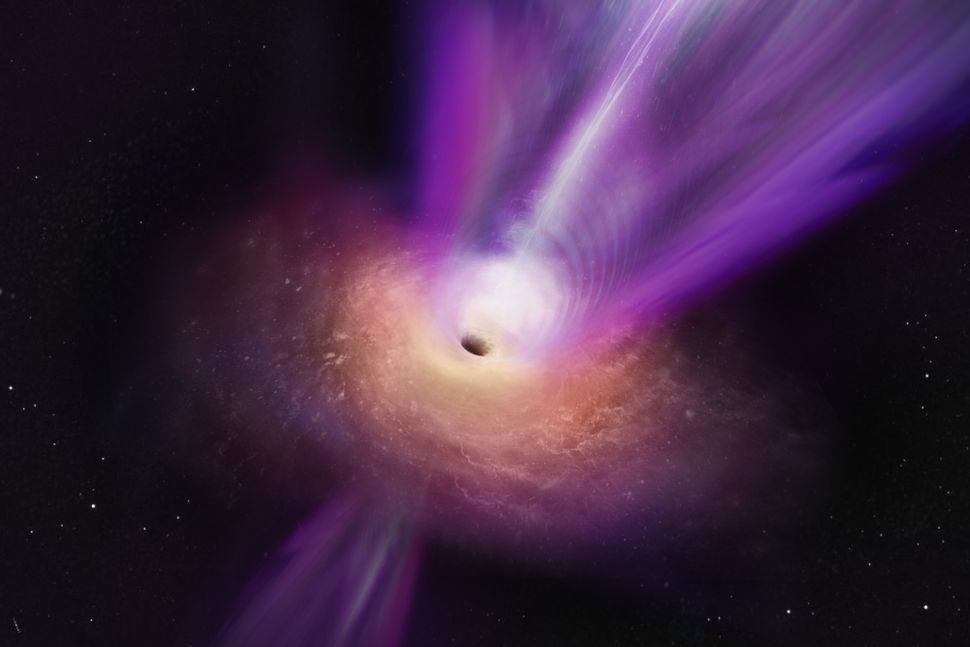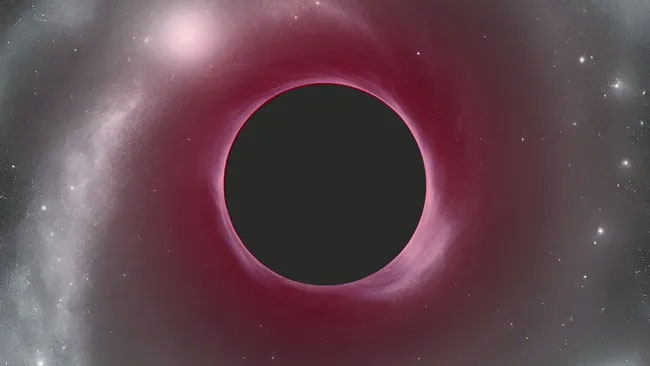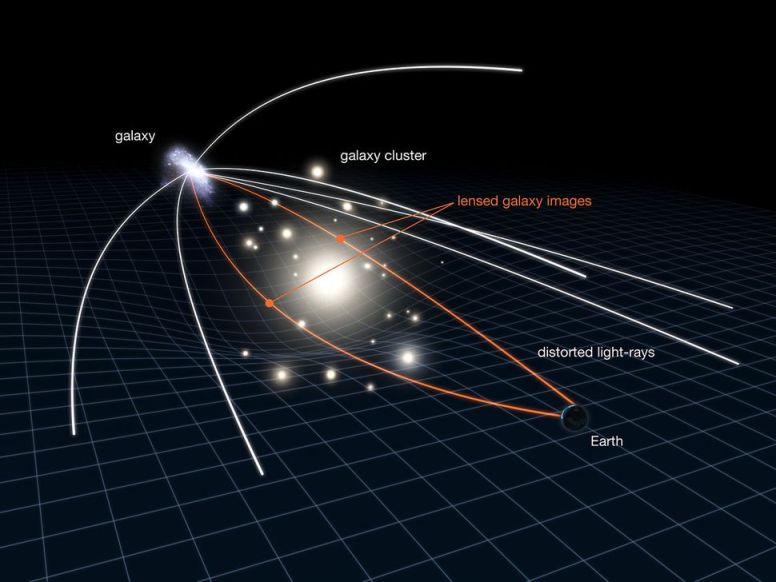Peering deep into space and time, two teams using the NASA/ESA/CSA James Webb Space Telescope have studied an exceptionally bright galaxy called GN-z11, which existed when our 13.8-billion-year-old universe was only about 430 million years old. Also studying JWST data, a team of astronomers led by Lukas Furtak and Adi Zitrin of Ben-Gurion University of the Negev were also able to determine the mass of the supermassive black hole. At about 40 million times the mass of the Sun, it is surprisingly massive compared to the galaxy it hosts.
Fulfilling its promise to change our understanding of the early universe, the James Webb Space Telescope is exploring galaxies from the beginning of time. One of them is the exceptionally bright galaxy GN-z11. First discovered by the NASA/ESA Hubble Space Telescope, it is one of the youngest and most distant galaxies ever observed, and it is also one of the most mysterious. Why is it so bright? Webb may have found the answer, reports the journal Astronomy & Astrophysics.
The team studying GN-z11, along with Webb, has found the first clear evidence that the galaxy hosts a central supermassive black hole that is rapidly accreting matter. Their discovery makes it the most distant active supermassive black hole discovered to date.

GN-z11 in the GOODS-North field
“We found extremely dense gas, which is common in the vicinity of gas-accreting supermassive black holes,” said lead researcher Roberto Maiolino of the Cavendish Laboratory and the Kavli Institute for Cosmology at the University of Cambridge in the UK. “This was the first clear indication that GN-z11 contains a black hole that is accreting matter.”
Using Webb, the team also found signatures of ionized chemical elements, which are typically seen near accreting supermassive black holes. They also found that the galaxy was ejecting very powerful winds. Such high-speed winds are typically driven by processes associated with vigorously accreting supermassive black holes.
“Webb’s NIRCam (Near Infrared Camera) has detected an extended component tracking the host galaxy and a central compact source whose colors match those of the accretion disk surrounding the black hole,” said researcher Hannah Uebler, also of the Cavendish Lab and the Kavli Institute.
Taken together, these data indicate that GN-z11 hosts a supermassive black hole with a mass of two million solar masses that is in a very active phase of swallowing matter, which is why it is so bright.

Spectrum GN-z11
A second team, also led by Maiolino, used Webb’s NIRSpec (Near Infrared Spectrograph) to detect a gaseous clump of helium in the halo surrounding GN-z11.
“The fact that we don’t see anything but helium suggests that this clump must be quite pure,” Roberto said. “This is what theory and modeling expected in the vicinity of particularly massive galaxies of these eras — that there should be pockets of pure gas in the halo that can collapse and form Population III star clusters.”
Finding previously unobserved Population III stars – the first generation of stars formed almost entirely from hydrogen and helium – is one of the most important challenges in modern astrophysics. These stars are expected to be very massive, very bright, and very hot. Their signature will be the presence of ionized helium and the absence of chemical elements heavier than helium.
The formation of the first stars and galaxies marks a fundamental shift in the history of the cosmos, during which the Universe evolved from a dark and relatively simple state into the highly structured and complex environment we observe today.
In future Webb observations, Roberto, Hanna, and their team will study GN-z11 in more detail and hope to confirm the presence of Population III stars that may be forming in its halo.
The name “Population III” arose because astronomers had already classified the Milky Way’s stars as Population I (stars like the Sun that are rich in heavier elements) and Population II (older stars with low heavy element abundances found in the Milky Way’s bulge and halo, as well as in globular star clusters).
A supermassive black hole 40 million times more massive than the Sun powers a quasar that existed 700 million years after the Big Bang. Using the James Webb Space Telescope (JWST), astronomers have discovered an “extremely red” supermassive black hole growing in the dark early Universe, the journal Nature reports.
The red hue of the supermassive black hole as it appeared about 700 million years after the Big Bang is a result of the expansion of the universe. As the universe expands in all directions, light traveling toward us is “redshifted,” and in this case, the redshifted light indicates a cloak of thick gas and dust enveloping the black hole.

An artist’s impression of a supermassive black hole and its powerful jet. Astronomers want to know how these objects achieved their enormous masses in the early universe. NRAO/AUI/NSF
By studying the JWST data, a team of astronomers led by Lukas Furtak and Adi Zitrin of Ben-Gurion University of the Negev were also able to determine the mass of the supermassive black hole. At about 40 million times the mass of the Sun, it is surprisingly massive compared to the galaxy in which it resides.
The team also found that the supermassive black hole, which is about 12.9 billion light-years from Earth, is rapidly gobbling up gas and dust around it. In other words, it’s growing.
“We were very excited when JWST started sending back its first data. We were scanning the data coming in for the UNCOVER program, and three very compact but bright red objects stood out and caught our attention,” Furtak said in a statement. “Their ‘red-spotted’ appearance immediately made us suspect that it was a quasar-like object.”
Quasars are created when huge amounts of matter surround supermassive black holes like this one. This matter forms a disk of gas and dust, called an accretion disk, which gradually feeds the black hole. The black hole’s enormous gravitational pull churns this matter, creating high temperatures and causing it to glow.
In addition, matter that does not fall into the supermassive black hole is directed toward the poles of the cosmic titan. Particles in these regions are accelerated to speeds approaching the speed of light in the form of highly collimated jets. As these relativistic jets are ejected, the eruptions are accompanied by bright electromagnetic emissions.

This illustration shows an extremely red supermassive black hole in the early universe. Robert Lee
As a result of these phenomena, quasars powered by supermassive black holes in active galactic nuclei (AGNs) often become so bright that the light they emit often outshines the combined light of every star in the galaxy surrounding them.
The enormous amount of radiation emitted around this supermassive black hole has caused it to appear as a small dot in the JWST data.
“Analysis of the object’s colors showed that it was not a typical star-forming galaxy, further supporting the supermassive black hole hypothesis,” Rachel Bezanson of the University of Pittsburgh and co-leader of the UNCOVER program said in a statement. “Coupled with its compact size, it became clear that it was most likely a supermassive black hole, although it was still different from other quasars discovered at that early time.”
The early quasar would not have been visible even to JWST’s powerful infrared instrument without a little help from an effect predicted by Albert Einstein in 1915.
Einstein’s general theory of relativity suggests that objects of mass warp the very fabric of space and time, which are actually joined together into a single entity called “spacetime.” The theory goes on to say that gravity results from this curvature. The greater the mass of an object, the more “extreme” the curvature of spacetime.
So this curvature not only tells planets how to move around stars and around the centers of their home galaxies, but it also changes the paths of light coming from those stars.
The closer the light travels to an object of mass, the more its path is “bent.” Different paths of light from a single background object can thus be bent by the foreground or “lensing object,” changing the appearance of the background object’s location. Sometimes the effect can even cause the background object to appear in multiple locations in the same sky image. In other cases, the light from the background object is simply amplified, making the object appear larger. This phenomenon is known as “gravitational lensing.”
In the latest case, JWST used a galaxy cluster called Abell 2744 as a foreground lensing body to enhance the light from background galaxies that would otherwise be too distant to see. This revealed the extremely red quasar they focused on, initially in the form of three red dots.

This diagram shows how light from a background object is bent by a foreground object. NASA/ESA
“We used a numerical lensing model we built for the galaxy cluster to determine that the three red dots must be multiple images of the same background source, observed when the Universe was only about 700 million years old,” Zitrin said.
Further analysis of the background source revealed that its light must have come from a compact region.
“All the light from this galaxy would fit into a tiny region about the size of a modern star cluster. Gravitational lensing of the source gave us precise constraints on the size,” team member and Princeton University researcher Jenny Green said in a statement. “Even if you packed all the possible stars into such a small region, the black hole would end up making up at least 1% of the total mass of the system.”
The discovery further deepens the mystery of how supermassive black holes, which can be millions (or even billions) of times more massive than the Sun, grew to such enormous sizes during the early days of the Universe.
“Several other supermassive black holes in the early universe have now been found to exhibit similar behavior, leading to some intriguing insights into the growth of the black hole and host galaxy, as well as the interactions between them that are not yet well understood,” Green said.
JWST has found many “little red dots” over time. They may also indicate the feeding of supermassive black holes by quasars in the early universe, which could mean that the astonishing mystery of black hole growth may soon be solved.
“In a sense, this is the astrophysical equivalent of the chicken and egg problem,” Zitrin concluded. “We currently don’t know which came first, the galaxy or the black hole, how massive the first black holes were, or how they grew.”




